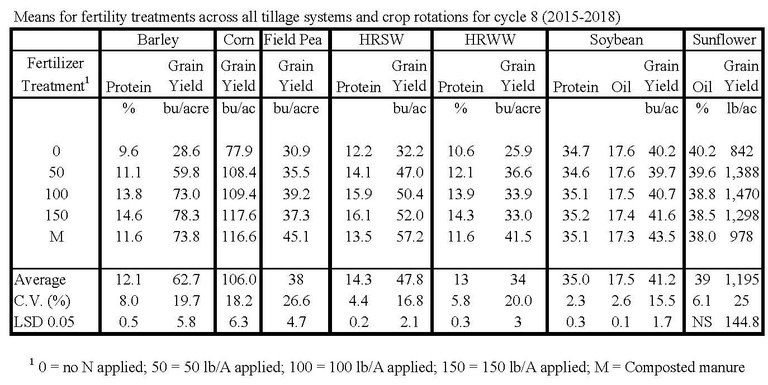Long-term Cropping Study - Nitrogen Fertility Revisited
Last month we discussed the impact of tillage system on grain yield.
This month we will look at nitrogen fertility treatments.
The fertilizer treatments are: (1) urea broadcast applied each spring to all plots, except field peas and soybeans, at 0, 50, 100, or 150 pounds of N per acre and (2) composted beef feedlot manure applied once at 200 pounds of N the first year of each cycle. These treatments are imposed in strips perpendicular to the three tillage systems: conventional, minimum tillage, and no till resulting in 15 sub-plots within each crop.
 Long term cropping study with tillage systems running vertically in the plots and the N fertility rates running laterally in the plots.
Long term cropping study with tillage systems running vertically in the plots and the N fertility rates running laterally in the plots.
Note: Composted manure sunflower plots were negatively impacted by preferential deer grazing most years.

As shown in this table, cycle eight yield tended to increase with increasing nitrogen rates. The composted manure treatment performed as well as comparable commercial fertilizer rates in the non-legume plots. The yield in field pea and soybeans were higher, possibly due to increased phosphorous and micronutrients allowing nitrogen fixation and nitrogen scavenging from higher organic matter mineralization. However, the protein content of the wheat crops was limited by the composted manure treatment, resulting in a significant price penalty at market. Soybean protein content was lower for the previous 0 & 50 pound rates, and as a result, oil content was higher. However, neither had a negative impact on price received at the elevator.
This is a complex study with many moving parts - please contact me to discuss particular points.
Ezra Aberle
Ezra.Aberle@ndsu.edu
Agronomy Research Specialist


